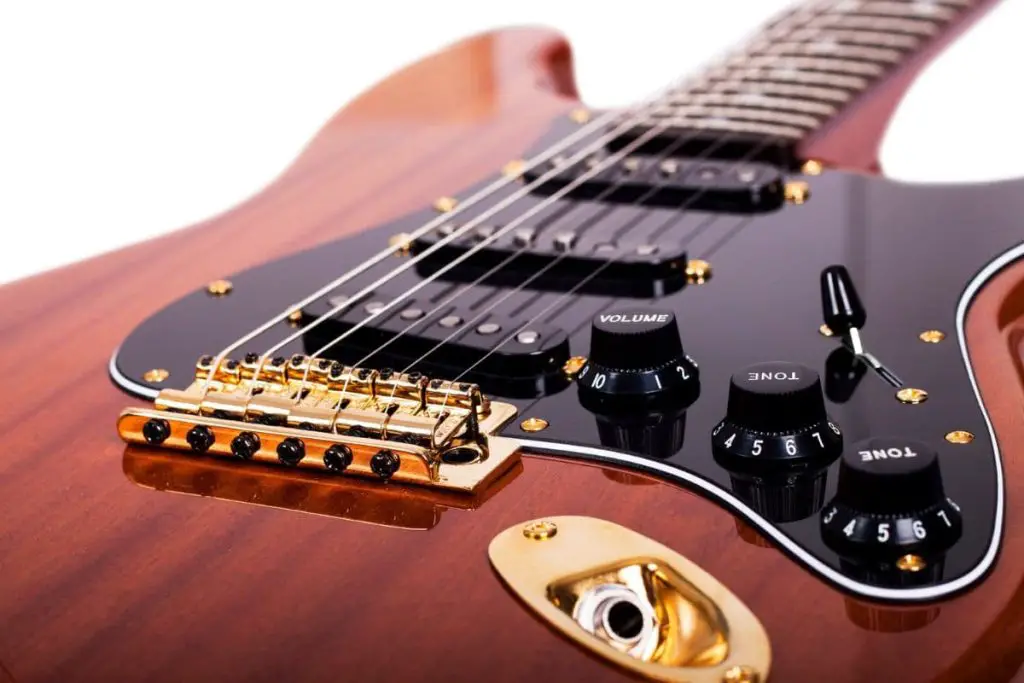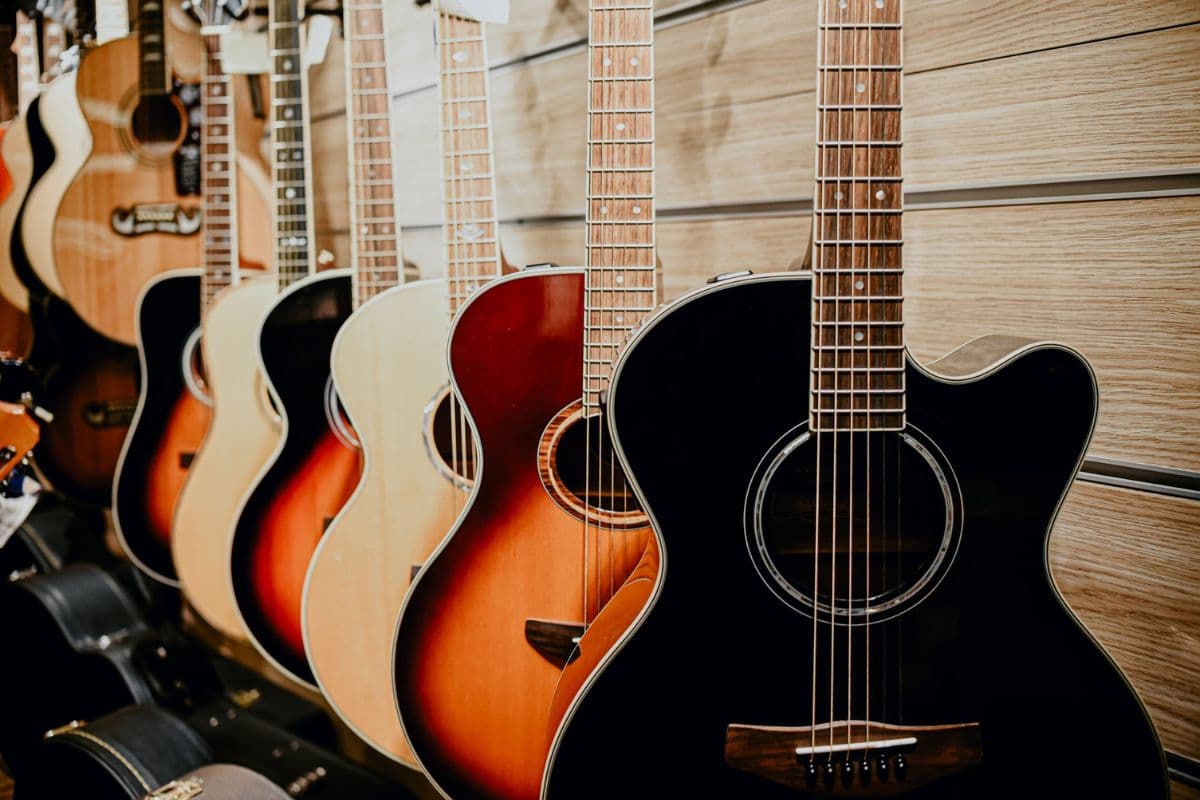You might’ve noticed that most guitars have multiple string sizes. The high E is much thinner than the low E. The thickness of each string gradually increases as you go up the strings. However, there are also numerous gauges (thicknesses) that help you choose lighter or heavier strings.
Guitar strings have different thicknesses because the thickness affects the pitch, tone, and depth. String gauges typically range from 0.010” to 0.014” on the high E string, though they can get as thin as 0.08”. Thinner strings are easier to play, but they don’t offer as much warmth and volume.
In this article, we’ll explain why the thickness of your guitar strings matters, how to choose the correct gauges for your strings, and what happens when you change the thickness.
If you want to find out what my recommended guitar gear is, then here is what I recommend on Amazon:
- Fender Cutaway Acoustic-Electric Guitar Bundle (MY FAVORITE GUITAR)
- Snark SN-8 Super Tight All Instrument Tuner (Easiest Tuner I’ve Used)
- 6 String Acoustic Guitar Capo (Best CAPO for quick changes)
- Dunlop Max Grip 1.0mm Nylon Picks (Thick Guitar Pick So You Don’t Lose Grip!)
- Universal Guitar Stand (Cheap & Minimalist Guitar Stand I Recommend)
- Levy’s 2″ Wide Quick Adjust Guitar Strap (Best Guitar Strap For Any Level)

How Does the Thickness of a Guitar String Affect Its Sound?
The thickness of a guitar string affects its sound by adding more volume, warmth, and bassy undertones. You’ll also notice that thinner strings tend to have more high-pitched sounds with treble-packed volume. Your guitar strings will be thickest at the low E string and thinnest at the high E string.
Here’s a detailed look at each of the ways thickness affects a guitar string’s sound:
- Thick strings add more volume when strumming and picking. Yamaha explains thicker strings tend to be a bit louder. Guitars are louder when they have more vibrations. The thickness of each string carries more vibrations as they get wider, which is why the low E is louder than the high E.
- Thin strings have a higher pitch and carry fewer vibrations. If you prefer light, relaxing music, then thin strings might be the way to go. Thinner strings brighten the sound, making each pluck and strum tiptoe rather than produce a louder, warm sound from the guitar’s body (or an amp).
- Thick guitar strings will have a warmer sound than thin strings. Since they carry the tone much longer, you’ll notice that they feel more inviting to many guitar players. Whether you prefer having a lively performance or relaxed strumming, thicker strings are a top choice for many performers.
- Thicker strings tend to provide more bass through the aforementioned vibrations. This rule applies to the low E string being much more bassy than the high E string, but it also applies to choosing a larger string gauge. The top four strings are bound, which helps them carry more vibrations.
- Thin strings are often easier to distinguish from one another when fingerpicking. If you want to produce clear notes that are easy to hear with every pluck, then thin strings are the better choice. They’re also easier to press when forming chords or barring frets, which makes them better for some beginners.
Although thickness is incredibly important, it’s not the only thing that influences your guitar’s sound. For example, the materials of the body, neck, nut, bridge, and saddle are heavily influential. Thicker strings carry more volume and bass, but they need a supportive guitar to show their full potential.
Are Thicker Guitar Strings Better?
Thicker strings are better if you prefer a warm, full-bodied sound. They also produce louder noises with each string. However, they might not be the best if you prefer fingerpicking or quiet strumming. Thicker strings are bold, and it’s hard to practice without people hearing you while you’re playing the guitar.

Here are some of the advantages of thicker strings:
- Thick guitar strings are much louder. If you want to be louder when you play your guitar, opt for larger strings. Bigger gauges help quite a bit, as does playing the deeper strings (starting with the low E). You can play higher on the low E string if you prefer high notes with more vibrations and volume.
- They’re better for strumming. Strumming often blends multiple notes together to form a chord. If you love strumming, then thick strings will help you make wonderfully blended melodies from start to finish. They’ll also make it easier to form chords if you ever decide to get a bigger gauge since you’ll be used to the tension.
- Many people believe thick guitar strings pair well with vocals. The aforementioned increased volume and chord blending mixes very well with singing and other instruments. You can mimic the sound of the warm, vibrating thick strings with your vocals, making them sound much more pronounced and professional.
- The sound from thick strings resonates longer in the body of the guitar. Whether you’re looking for dramatic effect or you want to carry the noise longer for other reasons, thick strings undoubtedly stay longer. The harder you strum on thick strings, the longer the sound will resonate in the guitar’s body.
- You won’t have to tune your guitar as often with thick strings. They hold their intonation much longer, so you’ll rarely have to worry about tuning before your practice sessions. Furthermore, thick strings don’t stretch as much because they’re more durable. You can rely on the first tuning session for a few weeks in most cases.
While thick strings offer plenty of advantages, they’re not always the best choice. It’s up to you to test thin, thick, and medium strings to know which are the right choice for your instrument. Below, we’ll break down how your guitar string’s thickness affects the ease of play.
Are Thicker Guitar Strings Easier to Play?
Thicker guitar strings aren’t easier to play because they require more tension and pressure. However, they’re worth mastering because they produce more volume. Beginners can choose any string gauge since the difference isn’t too big once you get used to the process. However, it’s a good idea to decide which gauge you want early on.
Gear Aficionado states you can change your guitar’s tuning to make any gauge string easier to play. If you prefer a specific gauge but want lighter strings, choose a higher key to tune into. If you don’t mind the gauge, but want to play in a higher key, get a capo to clip onto the desired fret of your guitar.
It’s worth noting that most guitars come with medium strings out of the box. If you want to alter their sound or ease of play, you can increase or decrease the gauge. However, medium strings are great for those who don’t mind a bit of extra effort for high-quality sound, bending, and chord transitions.
What Happens If You Put Thinner Strings on Your Guitar?
If you put thinner strings on your guitar, it’ll be a bit quieter and easier to play. However, you won’t get as much bass from the low E string. Nevertheless, the low E string will always provide a much deeper tone than the high E string, regardless of the set’s gauge. The strings should get thicker as you go from the bottom up.

Review this list to know the five things that happen with thinner strings:
- Your guitar will be easier to fingerpick and strum. Thin strings compress easier, making them a bit better for people who have a hard time with bar chords. They can also be better if you don’t have callouses developed on your fingers since they don’t require nearly as much pressure.
- You can expect a bit less volume from the strings. Thin strings produce smaller vibrations, thus reducing the sound amplified by the sound hole. Furthermore, they don’t resonate as long. These two facts combine to make them the optimal choice for people who don’t want to disturb their neighbors, roommates, and so on.
- You won’t hear as much bass from the low E string compared with higher gauges. The higher the gauge, the more bass you’ll hear from the bound strings. The increased binding on each of the lower strings with high-gauge sets also increases the volume, bass, and resonance while strumming.
- There’s a chance you’ll have to tune your guitar strings more often. Thin strings stretch a lot more than thick strings. This means you’ll probably have to make minor adjustments every now and then. However, it doesn’t hurt to tune your guitar every time you practice, regardless of the string’s thickness.
- You’ll be able to bend the strings a bit easier and quicker. Thin strings, also known as light strings, are better for people who bend them. This means people who prefer adjusting the pitch of a chord (such as playing bluegrass solos) would be better off with light or medium-light strings.
How Thick Should Your Guitar Strings Be?
Your guitar strings should be between 0.08” to 0.014” on the high E string. The low E string is usually much bigger, as it can get over 0.05”. However, you can base your string’s gauge on the high E string since most brands sell their strings based on the highest string. The thicker the strings, the louder the volume will be.
Rather than working about each string’s thickness, base your decision on the high E string. Those who prefer fingerpicking and easier fretting should stick to strings between 0.08” to 0.010”, whereas those who want more warmth and volume should try strings between 0.012” to 0.014”. If you enjoy both playstyles, opt for strings between 0.09” to 0.012”.
All guitar strings are labeled with numbers or colors to help you know which order they go. Make sure the thickest string is at the low E, and the thinnest string is at the low E. the strings will gradually get thinner, so follow their dimension if you need additional assistance.
What Gauge Strings Do Most Guitarists Use?
Most guitarists use a 9-gauge set, which refers to the high E string’s 0.09” measurement. The low E is typically 0.042”. Every string in between will gradually increase in size, but you don’t have to worry about their dimensions if you stick with a set. Never mix and match guitar string gauges if you want a uniform sound.

Some professionals and well-versed guitar players mix their string gauges because they prefer a specific sound for some songs. However, it can make it a bit more difficult for a beginner to get the hang of their string gauges if they don’t stick to a set. Wait until you’re comfortable with the gauge you prefer, then consider mixing if you want to.
Another way to know which strings you should get is to find out how your favorite guitarists sound. Research their string gauges and switch to those sizes. You don’t need to choose the same brand or material, though they definitely play a role in a guitar’s sound output.
How to Know If You Need Thicker Guitar Strings
To know if you need thicker guitar strings, ask yourself these questions:
- Do you prefer strumming or fingerpicking? If you enjoy strumming, then thick strings are typically better. They blend much better than thin strings, not to mention their louder volume output. On the other hand, thin strings are great for fingerpicking. If you enjoy both play styles, consider getting medium strings.
- Do you find it difficult to bar your fretboard? If it’s hard for you to do bar chords due to the required pressure, reduce your string’s gauge. Lower gauges are easier to fret. You can go with medium or medium-light if you don’t want to sacrifice the rich warmth of thick strings when you’re strumming or fingerpicking.
- Do you want volume or distinguish tones? You can strum or fingerpick with any gauge, though they’re better with the aforementioned sizes. However, you’ll need thicker strings if you want to play loudly. Lighter strings distinguish each note, making them better for those who don’t mind the loss of depth.
- Do you play with a band or by yourself? If you play with a band, then it’s best to go for medium or heavy strings. These strings help you remain loud enough to play with the rest of the group. If you’re by yourself, you can choose any string size based on your personal preference and play style.
- Are the nut and saddle on your guitar designed for a specific gauge? While most guitars can use any string gauge, some of them only work with a specific size. Remove the strings and check if they’re deep or shallow. If they’re too shallow, you might not be able to use thick strings because they’ll fall out of the nut or saddle.
The good news is that most guitar strings are relatively affordable. You don’t have to break the bank to get a high-quality set of strings. Choose a few gauges and find out which one works best for your play style. Once you find the right set, you can purchase them in bulk to have plenty of backups in case a string snaps.

What to Know Before Changing a Guitar String’s Gauge
Before changing a guitar string’s gauge, you should know how much it’ll impact the way you play the instrument. If you switch from heavy strings to light strings, you’ll notice a massive difference. It might be better for most players to switch to medium, medium-light, or medium-heavy strings.
- Every 0.01” difference feels and sounds unique. We often suggest people switch only a couple of gauges. Too much change can alter the way you strum and fingerpick, not to mention the difference in the way it feels. Intermediate and advanced guitarists find it easier to make big changes in their string’s gauges, though.
- You’ll get more longevity out of thicker strings. According to Strummingly, thicker strings last longer because they’re much more durable. They don’t flex as much, but they have better structural integrity than thin strings. You might notice your high E string breaks, snaps, or discolors quicker than your low E string.
- It’s easier to play thin strings if you want to strum or fingerpick quickly. Not only does the slight difference in thickness let you move from one string to the next much faster, but it also means you don’t need to apply as much pressure. When you apply less force, you don’t have to stay on each string too long.
- Thick strings will toughen your fingers quicker. Callouses are a big part of playing the guitar. If you practice often, you’ll need tough fingertips. Playing with thicker strings will help you develop callouses, which reduces the pain and discomfort most beginners face at the start of their guitar journey.
The thickness of your strings plays a role in every part of your play style. Make sure you consider these pros and cons to know which set you want. Guitar strings are easy to come by, so you’ll have no problem finding out which gauge you prefer.
Final Thoughts
Guitar string thickness is incredibly influential and often overlooked by beginners. You’ll have an easier time with thin strings, but those who want more volume should opt for thick strings. Thin strings are also better for fingerpicking, whereas thick strings are a strummer’s dream come true.
If you want to find out what my recommended guitar gear is, then here is what I recommend on Amazon:
- Fender Cutaway Acoustic-Electric Guitar Bundle (MY FAVORITE GUITAR)
- Snark SN-8 Super Tight All Instrument Tuner (Easiest Tuner I’ve Used)
- 6 String Acoustic Guitar Capo (Best CAPO for quick changes)
- Dunlop Max Grip 1.0mm Nylon Picks (Thick Guitar Pick So You Don’t Lose Grip!)
- Universal Guitar Stand (Cheap & Minimalist Guitar Stand I Recommend)
- Levy’s 2″ Wide Quick Adjust Guitar Strap (Best Guitar Strap For Any Level)
Related Posts:
- How To Stop Guitar Strings from Breaking While Tuning
- How to Solo With an Acoustic Guitar (8 Easy Steps)
- 9 Ways to Make an Acoustic Guitar Quieter
- 20 Ways To Know if Your Guitar Is Acoustic or Classical
- 7 Steps to Making Your Acoustic Guitar Electric
- How To Play Guitar Without Looking (9 Training Methods)
- How To Keep a Guitar Strap From Falling Off (8 Ways)
- How To Fix a Loose or Broken Guitar Input Jack
- 11 Finger Stretching Exercises To Do Without a Guitar
- 15 Best Electric Guitar Strings
- Guitar String Tension Calculator
- Best Guitar Strings for Telecaster
- Best Guitar Strings for Fender Stratocaster
- Best Guitar Strings for Country Music
- Best Guitar Strings for Les Paul
- Best Guitar Strings for Bending
- Best Guitar Strings for Blues

